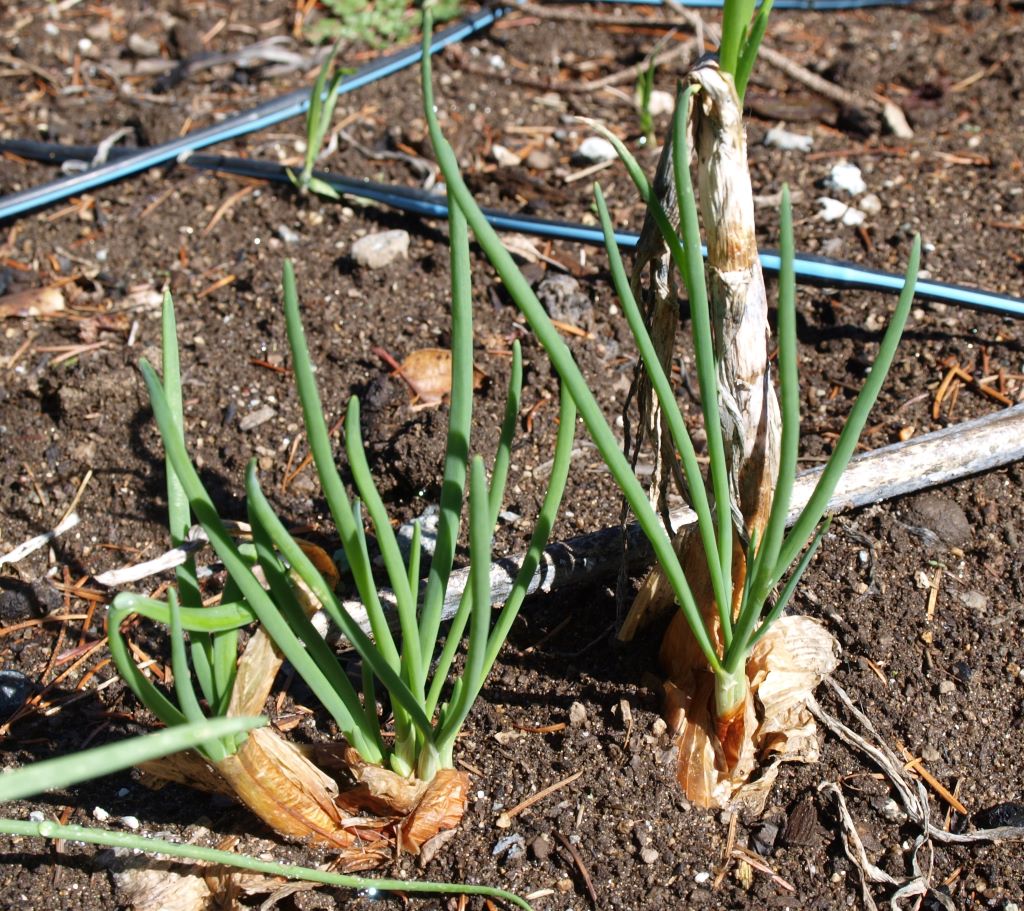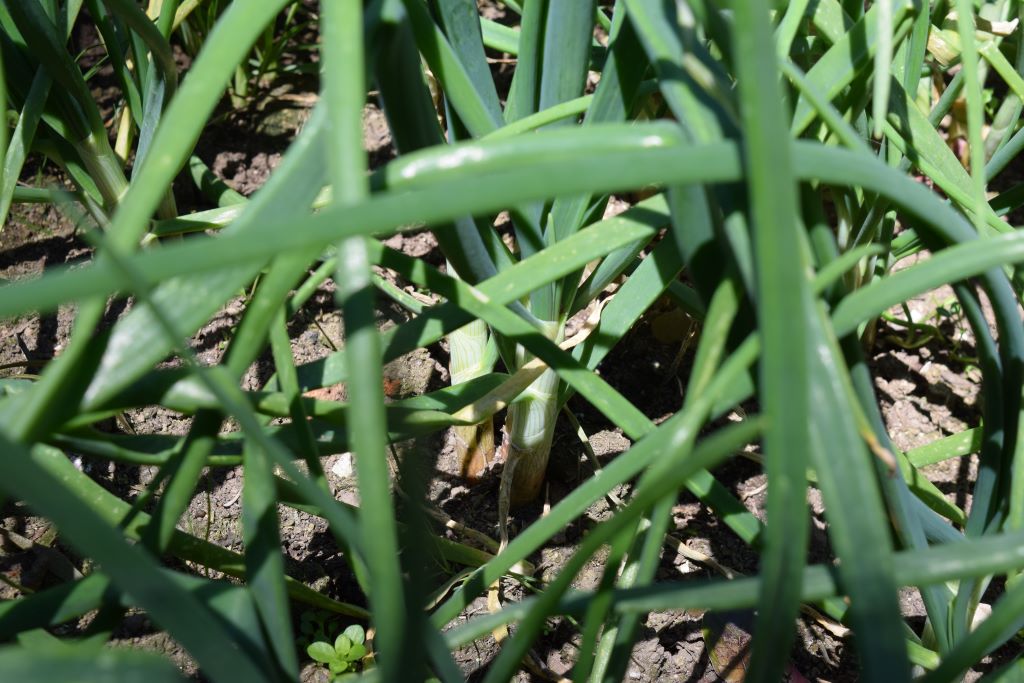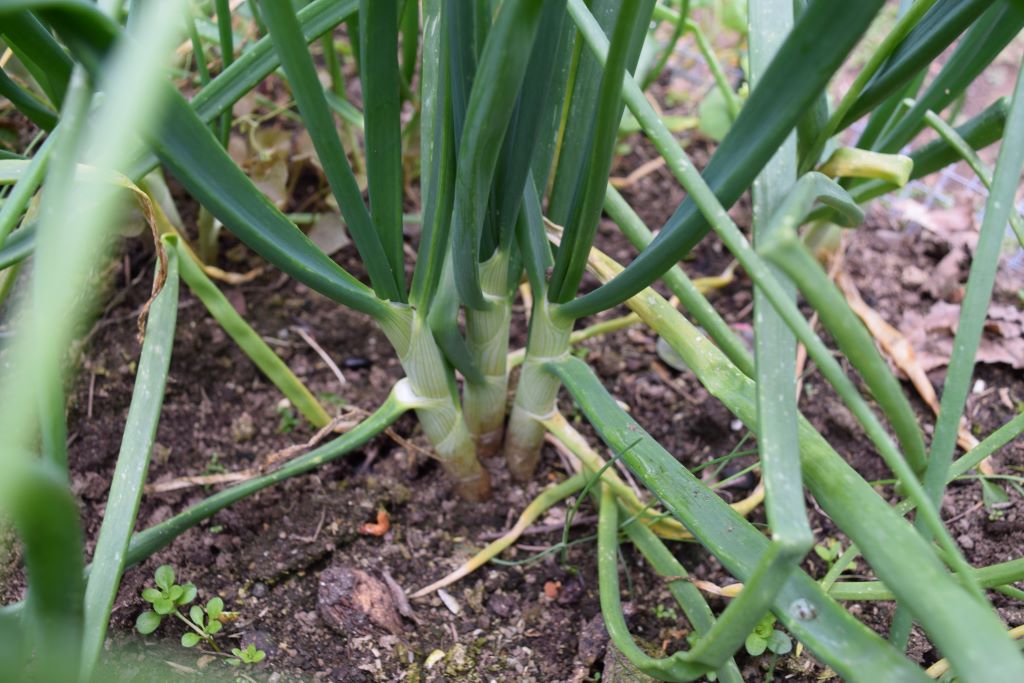Potato Onion
Allium cepa aggregatum group
Introduction: The potato onion is a type of perennial multiplier onion (like shallot) that is thought to have originated in Scandinavia. It has the same growth habits as the shallot and is cultivated in exactly the same ways. The major difference is that it produces much larger bulbs (up to 3˝ in diameter), so is actually more useful. It doesn’t have any connection to the potato except that it is usually propagated vegetatively (which is about as slender a connection as you can get).
Growing potato onions is ideally suited to home growing, you simply plant a bulb and harvest a clump of bulbs. It is so simple as to be almost foolproof.
This was a popular crop plant in North America when people grew their own food and many families handed it down, mother to daughter for generations (the very definition of an heirloom crop). It’s use declined drastically when people stopped growing much of their own food, as it doesn’t work so well as a commercial crop. It is now almost forgotten, to the point where it is often difficult to find bulbs to plant.
Crop value: This is an outstanding perennial food crop (probably the best overlooked one) and really should be grown by everyone.

Ease of growing: In many ways this is the easiest of all the onions to grow. It has the advantage of vegetative propagation as in the shallot, but produces bigger bulbs.
Nutritional content: Like the onion they are rich in vitamin C, potassium, calcium and a variety of beneficial phytochemicals.
Climate: They like the same kind of climate as other onions, cool weather (50 – 70°F) for growth and slightly warmer 70 – 80°F (and dry) weather for bulbing and ripening.
Like onions they are day length sensitive, but I didn’t realize this for a long time, because I always plant in fall, which gives them plenty of time to grow before day length triggers bulbing. Of course day length isn’t such a big issue because they are perennial and in the ground for a long time.
How they grow: The bulb sends up several shoots and grows into a cluster of green plants. Eventually the old bulb shrinks away and each shoot in the cluster forms a new bulb on the soil surface. Generally each plant will produce 3 – 5 bulbs, but sometimes there is as many as 12. As a rule of thumb you can expect to harvest at least five times what you plant, which should give you some idea how much you need to plant (and save) to supply yourself with onions for the year.
I have read that if you plant a large bulb it will make a cluster of many small ones, whereas if you plant a small bulb it will make one large one. I can’t verify this though, because I haven’t paid that close attention (I only have a short attention span). In practice I tend to just harvest them all, eat the biggest ones and replant the small ones.
| About Potato Onion Perennial Hardiness zones: 3 – 10 Soil temp: 50 (60 – 65) 75°F Seed viability: 1 – 4 years Yield:1 – 4 lb sq ft Growing temp: 50 (60 – 70) 75°F |
Soil
pH 6.0 (6.5) 7.0
Potato Onions, not surprisingly, prefer the same kind of soil as onion, well-drained, rich, loose and moisture retentive. However they will do fine in a less than ideal soil. It does need to be well-drained though, as they may rot over the winter if it is too wet. If your soil isn’t very well-drained, you should grow them in raised beds, or on ridges of soil.
Soil preparation: Incorporate 2˝ of compost or aged manure into the top 6˝ of soil, to supply nutrients and aid in moisture retention. This is particularly important if your soil is light and doesn’t hold water well.
You may also want to add colloidal phosphate to supply phosphorus and wood ashes or greensand for potassium. You could also use a standard fertilizer mix, though they don’t need a lot of nitrogen.
If the soil is very acidic add lime to raise the pH.

When to plant:
Like other onions the potato onion is day length sensitive, so should be planted in fall or early spring. This gives it plenty of time to grow before the appropriate day length triggers bulbing.
Fall: In milder climates the bulbs are often planted in fall, along with garlic and shallot, as this gives them longer to grow and a bigger harvest (though this doesn’t always happen). Another advantage is that if you plant in fall, you don’t have to store the bulbs over the winter. In cold climates fall planted bulbs might not survive a particularly cold winter, so there is some risk. Fall planting also encourages bolting, whereas spring planting doesn’t. This is good if you want to save seed, bad if you don’t.
Spring: In colder climates spring planting makes the most sense, especially if you don’t want them to bolt (which takes energy from the bulbs). You can plant as soon as the ground can be worked in spring, which may be a month before the last frost (or even earlier in some cases).
Spring planted bulbs usually mature a little later than those planted in fall. If you have enough bulbs you could plant at both times, to spread out the harvest and provide a little extra insurance against loss.
Spacing:
Beds: Space the plants 6 – 8˝ apart in wide beds.
Rows: Space the plants 3 – 4˝ apart in the rows, with 18 – 24˝ between the rows.
Planting: Plant as you would a shallot, so the bulb is just covered with soil (some people plant deeper in fall for better protection from the cold).

Growing from seed: The potato onion can be started from seed quite easily. The difficult part is finding seed to plant, as they don’t often produce it.
The disadvantage of vegetative propagation is that over the years bulbs can get infected with virus diseases, which can result in small (though perfectly usable) bulbs. When plants are grown from seed they can produce big, beautiful virus free bulbs, 3 – 4˝ in diameter, in their first year.
Plants grown from seed will also show a lot more genetic variation because they aren’t all clones of the same plant. There may be differences in color, size, shape and bulbing habit. You can simply choose bulbs of those you like best for replanting the following year and propagate them vegetatively.
Care: These are surprisingly tough plants. I have had small plants appear to die in hot dry conditions, only to reappear and produce bulbs the following summer.
Watering: Water the plants regularly while they are growing rapidly. Stop watering when the bulb forms and the leaves start to turn yellow, so the neck can dry out.
Mulching: In cold climates overwintering bulbs will benefit from the protection of a thick mulch. This should be removed after all hard frosts are past, so the soil can warm up.
Problems: The only major difficulty I have found with potato onion is finding material to plant. It is a lot easier to grow than it is to find. This is unfortunate because if more people could try it, then it would be much more popular. This would make it more available, so even more people could try it. Fortunately it is gradually becoming easier to find.
Insurance: The problem with growing a perennial plant such as this is if something goes wrong you can lose everything. One year all of my stored potato onion bulbs were eaten by wood rats, fortunately I had overlooked a few bulbs in the ground and was able to carry on with these. The best way to avoid this is by encouraging everyone you know to grow it too. This provides invaluable insurance against loss.
Another form of insurance is to plant some of your bulbs in fall and some in spring. Then if your fall bulbs meet an unanticipated fate, you haven’t lost everything.
Seed saving: Many people say it is hard to get potato onions to flower and produce seed, but I haven’t found this to be a problem. In fact my fall planted bulbs produce seed so readily I have had to start spring planting too (if a bulb produces seed it will use most of its energy for that.)
Harvest:
When: This is a fairly short season crop and a spring planting can be harvested in late summer, when the leaves start to die back.
How: The mature bulbs sit on the ground and can often be simply picked up. If the soil is hard you may have to loosen it with a fork first.
Curing: After harvest you need to keep the bulbs in a dry place to cure (just as you would other onions).
Storage: Store your best bulbs in a cool, dark, rodent-proof place (this is especially important for any bulbs you will use for replanting). Potato onions store exceptionally well and will often stay good for up to 12 months.
Of course you need to set aside a portion of your crop for replanting the following year.
Varieties: A few varieties do exist, but think yourself lucky if you can find any potato onions at all. Even if you find somewhere to get the bulbs, you may have another problem in that they are only usually available at the end of the growing season (around October) and often sell out quickly. If you find somewhere that sells them it is a good idea to order early.
If you grow them from seed you will find quite a bit of variation in each plant and can create your own varieties.
Kitchen use: You can use the bulbs and green leaves as you would those of onions. The bulbs will be different sizes so you can choose the size you need for whatever dish you are cooking.
The potato onion is nice when fried with potatoes (which is another very slender connection between the two).










